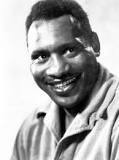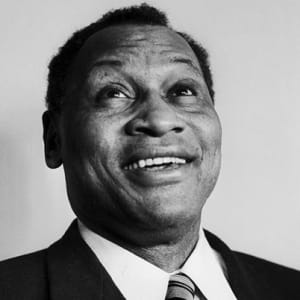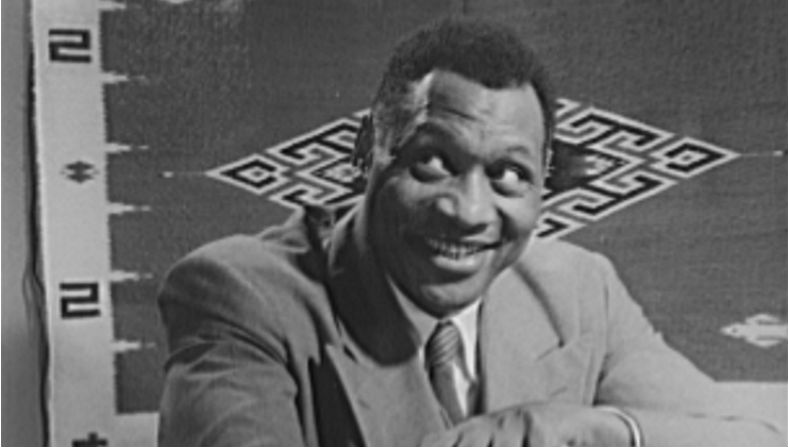Paul Robeson (9 Apr 1898 – 23 Jan 1976): Lessons from a Remarkable Life
BIOGRAPHIES, 5 Apr 2021
Tayo Aluko | Counterfire – TRANSCEND Media Service
Black Lawyer, Singer and Football Player, Paul Robeson’s Extraordinary Life Holds Many Lessons for the Present Day
Full Biography HERE
Black History Month [February] presents an annual opportunity for contemporary audiences to become better acquainted with many significant figures in Black people’s continuous struggle for freedom, equality and justice. The name most likely to be repeated, even ahead of British figures like Olaudah Equiano, Ottobah Cugoano, Robert Wedderburn and Robert Mandeville, is that of Martin Luther King, Jr. From the Caribbean come names like Toussaint L’Ouverture, Sam Sharpe, Bussa, Claudia Jones and C.L.R. James. African figures include Nana Yaa Asantewa, Patrice Lumumba, Kwame Nkrumah, and of course Nelson Mandela. Other familiar American names include Rosa Parks, Angela Davis, Stokely Carmichael, Harriet Tubman, Sojourner Truth, and Frederick Douglass, who despite having died in 1898 was recently described by the current U.S. President as “doing a great job.”
There are many stark differences between the current president and his immediate predecessor, one being the latter’s knowledge of, and interest in the Black struggle. It is likely that Barack Obama knows all the aforementioned names, and he referenced many of them in his speeches. One name, however, seems never to have passed his lips (more likely due to political expediency than ignorance) and that is that of Paul Robeson.
Robeson was born in Princeton, New Jersey on April 9, 1898, the youngest of five children of Reverend William Drew Robeson and Maria Louisa Bustill. William Drew had been born on a slave plantation in Martin County, North Carolina, but escaped at the age of fifteen, to Pennsylvania, studied at Lincoln University and became a church minister in Princeton. Maria Louisa had been born into a prominent Philadelphia Quaker family, with mixed African, Anglo and Native American ancestry. Paul spoke little of his mother (he had been there at age six when her dress caught fire and she died, leaving William Drew to bring up all his children alone) but he always said how much of an influence his father had been, having learned from him his great oratorical skills, and subjects as diverse as Latin, Hebrew, and African History.
With his father’s coaching, Paul won a scholarship to Rutgers College (now Rutgers University) in New Brunswick, in 1915, and excelled as a scholar, debater and sportsman, all despite being the only Black boy in a college where the other students were mostly sons of Southern plantation owners. He studied law at Columbia University and joined a New York law practice as a trainee in 1923. Due to racism in the firm, Paul and his wife Eslanda decided that he should try for a career on the stage, having shown promise with his sonorous bass voice and good looks.
 Robeson became successful almost immediately, performing both in England and in America, and when performing the role of Joe in Showboat at the Theatre Royal in London’s Drury Lane, his rendition of Ol’ Man River became an instant hit, catapulting him into stardom on both sides of the Atlantic. He achieved success in concert halls, on stage and on screen, and became the toast of the town in Britain, and to a lesser extent in the United States, given the racism there.
Robeson became successful almost immediately, performing both in England and in America, and when performing the role of Joe in Showboat at the Theatre Royal in London’s Drury Lane, his rendition of Ol’ Man River became an instant hit, catapulting him into stardom on both sides of the Atlantic. He achieved success in concert halls, on stage and on screen, and became the toast of the town in Britain, and to a lesser extent in the United States, given the racism there.
One night during his run in Showboat, Robeson was drawn by the sound of a group of Welsh miners singing on the street. They had marched to London from South Wales to highlight their terrible working conditions. Hearing their story made Paul realise for the first time how white people could exploit other white people, and his friendship with the Welsh miners and other working class Brits introduced him to Socialism and Communism. He first visited the Soviet Union in 1934, sending his son Paul Jr. to school there shortly after.
Like several African Americans who found living in Europe much easier than in Jim Crow America, the Robesons made London their home between 1929 and 1939. While pursuing his career from his London base, Paul enrolled at SOAS to study Linguistics and Languages, becoming fluent in several languages, including some African ones. At SOAS, he met many Africans who would eventually become prominent leaders in independent countries, among them Nnamdi Azikwe, Kwame Nkrumah and Jomo Kenyatta. His interest in African liberation and wider anti-imperialist struggles was born here, as was his determination to fight fascism in Europe and elsewhere. He made a detour from a European tour in June 1937 to join in a concert held at the Royal Albert Hall to raise funds for the Spanish Republican cause. From the stage, he made a speech in which he said,
“The artist must elect to fight for freedom or slavery. I have made my choice. I had no alternative… The liberation of Spain from the oppression of fascist reactionaries is not a private matter of the Spaniards, but the common cause of all advanced and progressive humanity.”
The import of an African American star standing on a British stage speaking on behalf of Spanish anti-fascists in 1937 cannot be overestimated, and with all his other interests, he became a target of MI5, the FBI and, in Canada, the RCMP. Despite this, his career continued to flourish until after World War Two. Whilst the Soviet Union and the United States had previously been allies, when the Cold War set in, Robeson was expected to fall in line with everybody else and denounce Moscow and Communism, which he refused to do. In a speech at the Paris Peace conference in April 1949, he said,
“We shall not make war on the Soviet Union. It is unthinkable that American Negroes would go to war on behalf of those who have oppressed us for generations against a country which in one generation has raised our people to the full dignity of mankind.”
This was distorted by the press back home, and by the time he returned, he had been transformed from the country’s most popular artist to Public Enemy No. 1 – so much so that an outdoor concert he was due to give on 28th August that year had to be abandoned due to a violent riot by local vigilantes. Refusing to be silenced, he announced that he would return the following week, and with New York trade unions organising a guard of a few thousand men to protect him and his audience, the concert went ahead on 4th September, followed by another huge riot in which the local anti-Communist, anti-Semitic and anti-Black sentiments of many were violently manifested.
This incident marked the beginning of Robeson’s downfall. Performing and recording opportunities evaporated, his passport was revoked the following year, and his annual income fell from $100,000 to $6,000. During this eight-year period, he continued to speak his mind, and published a book, Here I Stand, which was part memoir, part manifesto, to uncompromisingly set the record straight. In the text, he related for example one of his responses at the 1952 McCarthyite House UnAmerican Activities Committee hearing:
“I stand here struggling for the rights of my people to be full citizens in this country. They are not–in Mississippi. They are not–in Montgomery. That is why I am here today … You want to shut up every colored person who wants to fight for the rights of his people!”
The 1958 publication of Robeson’s book coincided with the return of his passport, and he immediately embarked on a gruelling five-year world tour during which he and his wife Essie suffered periods of serious ill health, and in 1963 the pair returned to New York. Asked by a reporter at the airport if he had come back to take part in the civil rights movement, he replied,
“I’ve been a part of the civil rights movement all my life.”
The forgetting of Paul Robeson had begun, but his complex life story holds many lessons for today, and could be a valuable lens through which to look at and understand today’s world.
__________________________________________________
Tayo Aluko is the writer and performer of two one-man plays: Call Mr. Robeson and Just an Ordinary Lawyer.
Go to Original – counterfire.org
Tags: Activism, Biography, Black Culture, History, Human Rights, Inspirational, Nonviolence, Socialism, USA
DISCLAIMER: The statements, views and opinions expressed in pieces republished here are solely those of the authors and do not necessarily represent those of TMS. In accordance with title 17 U.S.C. section 107, this material is distributed without profit to those who have expressed a prior interest in receiving the included information for research and educational purposes. TMS has no affiliation whatsoever with the originator of this article nor is TMS endorsed or sponsored by the originator. “GO TO ORIGINAL” links are provided as a convenience to our readers and allow for verification of authenticity. However, as originating pages are often updated by their originating host sites, the versions posted may not match the versions our readers view when clicking the “GO TO ORIGINAL” links. This site contains copyrighted material the use of which has not always been specifically authorized by the copyright owner. We are making such material available in our efforts to advance understanding of environmental, political, human rights, economic, democracy, scientific, and social justice issues, etc. We believe this constitutes a ‘fair use’ of any such copyrighted material as provided for in section 107 of the US Copyright Law. In accordance with Title 17 U.S.C. Section 107, the material on this site is distributed without profit to those who have expressed a prior interest in receiving the included information for research and educational purposes. For more information go to: http://www.law.cornell.edu/uscode/17/107.shtml. If you wish to use copyrighted material from this site for purposes of your own that go beyond ‘fair use’, you must obtain permission from the copyright owner.
